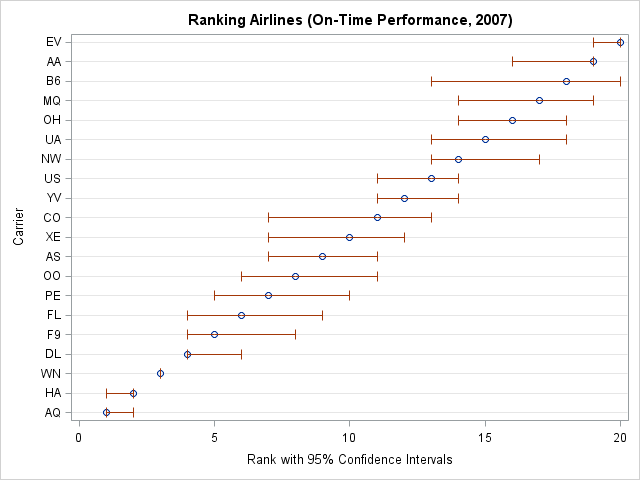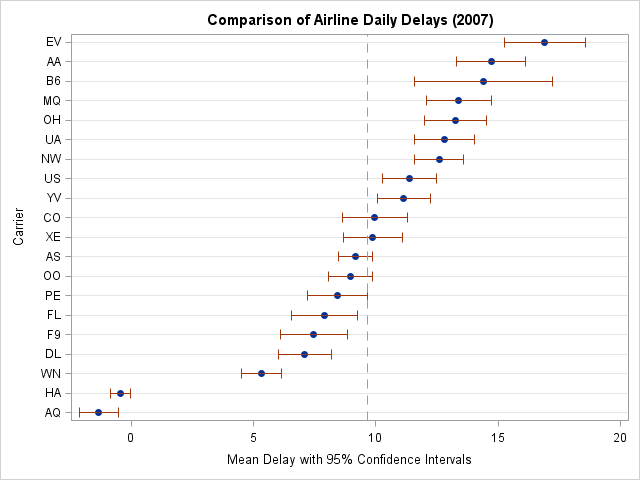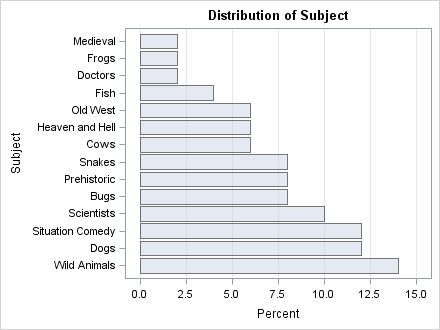All Posts

In a previous post, I described how to compute means and standard errors for data that I want to rank. The example data (which are available for download) are mean daily delays for 20 US airlines in 2007. The previous post carried out steps 1 and 2 of the method

Many SAS users love "undocumented features" within SAS software that they have found or heard about. Sometimes they can be really useful, and the fact that they are undocumented adds to the mystique. Some users have written entire conference papers on the subject. After 35 years of evolution, SAS contains

When you create a character matrix in SAS/IML software, the initial values determine the number of characters that can fit into any element of the matrix. For example, the following statements define a 1x3 character matrix: proc iml; m = {"Low" "Med" "High"}; After the matrix is defined, at most

I recently posted an article about representing uncertainty in rankings on the blog of the ASA Section for Statistical Programmers and Analysts (SSPA). The posting discusses the importance of including confidence intervals or other indicators of uncertainty when you display rankings. Today's article complements the SSPA post by showing how


I believe I would have interviewed AnnMaria De Mars even if you hadn't sent me scads of e-mails and tweets suggesting her as a perfect candidate for the SAS Rock Stars series. I "met" AnnMaria when I started looking for SAS users on Twitter – nearly three years ago while

I recently blogged about how to eliminate a macro loop in favor of using SAS/IML language statements. The purpose of the program was to extract N 3x3 matrices from a big 3Nx3 matrix. The main portion of my PROC IML program looked something like this: proc iml; ... do i=0
SAS procedure SUMMARY is a quick method of converting your detail table to a fully summarized one. Included is a sample. The key option to set is the NWAY - this generates the lowest level of summary for use in the OLAP cube. Essentially - the class statement contains all
In the computer software industry, 35 years is like an eon. I mean, 35 years ago, the computing power that I carry around within my mobile phone didn't even exist all in one place; but if it did, it would have filled an entire building. That's why the recent posting

Statistical programmers can be creative and innovative. But when it comes to choosing names of variables, often x1, x2, x3,... works as well as any other choice. In this blog post, I have two tips that are related to constructing variable names of the form x1, x2,..., xn. Both tips

We're having an early spring in North Carolina. Trees are budding, flowers are blooming, and the warmer temperatures make even a pistol whipping more enjoyable. What better way to take advantage of the new season than filling your spring with educational opportunities in forecasting. Plan in Perfect Sync with Customer

Loony. Zany. Brilliant. Hysterical. Those are some of the adjectives I use to describe The Far Side® cartoons by Gary Larson from the 1980s and early '90s. I recently rediscovered an old book, The Far Side Gallery 2, which collects some of the best of Larson's wonderfully wacky cartoons. Every

I recently asked chair Debbie Buck some questions to help us learn more about the upcoming conference. Here’s what she had to share – good reading ahead! 1) How is this year’s conference different from SAS Global Forum 2010? What’s New? SAS Global Forum 2011 includes a number of changes
SAS Global Forum 2011 just over two weeks away. The R&D and product management teams are preparing the demos to show on stage during the highly-visible opening sessions. A tremendous amount of work goes into planning the program. It's great to see what they come up with. When it comes

In a previous blog post, I showed how to use the SAS/IML SORT and SORTNDX subroutines to sort rows of a matrix according to the values of one or more columns. There is another common situation in which you might need to sort a matrix: you compute a statistic for






